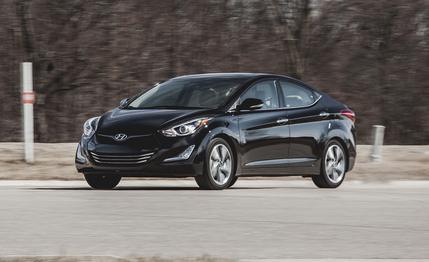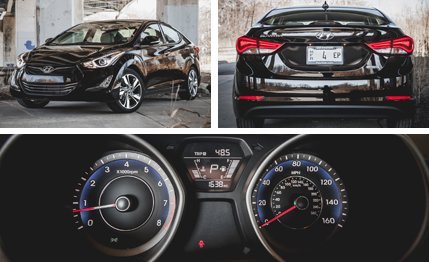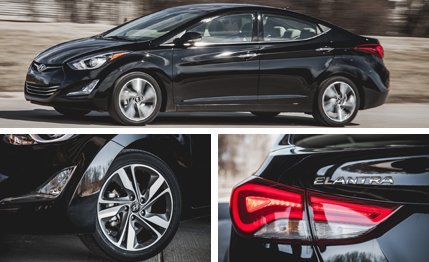
 Instrumented Test
Instrumented Test
Measured on a style-per-dollar basis, which is how many customers seem to determine their new-car choices, the Hyundai Elantra scores big. It packs plenty of features under a modest price ceiling, even if you go for the top trim level, the Limited, as tested here. Mild but effective design amendments for 2014 keep the Elantra, introduced in this fifth-generation form for 2011, looking fresh.
The biggest news for the 2014 Elantra is a 2.0-liter direct-injection four on some models that boasts 172 horsepower. The Limited, though, carries on with the previous 145-hp, 1.8-liter four mated to its standard six-speed automatic (several other Elantra trim levels offer a manual transmission). In sedans, the 2.0-liter only appears in a new Sport model; the coupe and the GT see wider application.
Without the power upgrade, the Limited feels pretty familiar, which is to say, the power is merely adequate. Drive quality remains lazy from an engine that doesn't much like to rev and a transmission programmed to help maximize fuel economy rather than fun.


Heavy on the Equipment
New headlamps, fog lights, and LED taillights lend a generally richer impression to the swoopy exterior. Inside, the feature-laden theme carries forward with power-adjustable front seats, heated seats front and rear, leather trim, a tilting-and-telescoping steering column, and—when equipped with the $2750 Technology package on this example—navigation on a seven-inch screen, a rearview camera, a proximity key, climate control, and a sunroof. The dashboard screen still presents a warning about distraction every time you start the car, but after you're past that, it offers one of the easiest phone-linking systems in the biz.
Floor mats were the only other option here ($125), bringing the total to $25,335. That’s well below the $30,000 average sticker price on a new car and nets one that has most of the telematics and comfort-and-convenience bells and whistles that once were exclusive to high-end luxury brands. That was the case before, though; what's mostly new for the 2014 edition is that you stand half a chance of enjoying your iTunes library or satellite radio because Hyundai reduced noise in the cabin via more effective insulation.
Light on the Power
Not surprisingly, then, the curb weight as measured on our scale is up an even 100 pounds at 2921 versus the 2821 we recorded for a 2011 Limited sedan. Hyundai officially states a little less power for the 1.8-liter than it did originally (claims of 148 horses and 131 lb-ft in 2011 are 145 and 130 today), just as it cites more-realistic fuel-economy ratings. The original 29 city and 40 highway mpg EPA ratings were revised downward to 27/37. Our observed 27 mpg falls short of the EPA combined rating of 31 mpg, perhaps because of how often we slammed the pedal to the mat looking for better acceleration.
This was not just because we're spoiled by all the high-powered cars visiting our parking lot. The new Limited turns out to be, well, more limited than we expected. At the track, it took a leisurely 9.4 seconds to achieve 60 mph and a full 17.3 seconds ticked away before it went a quarter-mile, at that point registering 83 mph. That's 0.8 second longer to 60 mph than we recorded in the 2011 version and 0.7 second and 1 mph slower down the drag strip, more degradation than you'd expect for a 100-pound weight gain and a 3-hp loss.


The 70-to-0-mph braking distance of the 2014 also suffers compared with that of the 2011 model, but less so, making the stop in 175 feet against 172 for the earlier model. Look to the tires: Both cars had the Limited-standard 17-inch wheels and 215/45s with all-weather M+S markings, but the 2011 rode on Continental ContiProContacts, whereas the 2014 had Hankook Optimos. On the skidpad, we recorded 0.85 g with moderate understeer this time; weather forbade performing that test with the 2011 version.
The “Drive Selectable Steering Mode” adjustments still vary the effort without adding any feel, although Hyundai literature claims the Limited's version is “sport tuned.” Riding on Hankooks this time, the 2014 model’s suspension does feel more compliant than the “unnecessarily stiff and noisy” label we pasted on its predecessor. The attention to noise control helps with the road roar as well as engine thrash. Even though NVH is better, this Elantra still lacks the refinement in handling, steering, and ride control that you'd find from competitors wearing a Mazda 3, VW Jetta, or Ford Focus badge. It's what you trade off to get more gizmos, and so much styling, per dollar invested.
This is an economy car striving hard to impersonate a luxury sedan, except for the part where real luxury sedans have enough power that you never think about it. The Sport with the new engine might be a different story, but with the 145-hp Elantra Limited and SE, there's only enough power for those drivers who never think about using it, lest the “eco” light blink out for a second.